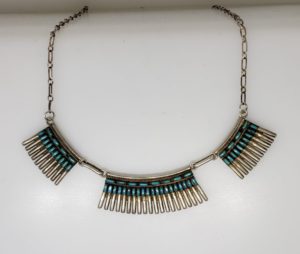 First of all, Zuni jewelry-making dates to Ancestral Pueblo prehistory. Most noteworthy, early Zuni use stone and antler tools, wood drills with flake stone, or cactus spine drill bits. Generally speaking, they use abrading tools made of wood and stone, sand for smoothing, and fiber cords for stringing.
First of all, Zuni jewelry-making dates to Ancestral Pueblo prehistory. Most noteworthy, early Zuni use stone and antler tools, wood drills with flake stone, or cactus spine drill bits. Generally speaking, they use abrading tools made of wood and stone, sand for smoothing, and fiber cords for stringing.
Most importantly, other than silver jewelry, introduced to Zuni Pueblo in the 19th century, most of the materials common to Zuni jewelry makers in the 20th century, have always been in use in the Zuni region. In addition, these materials include turquoise, jet, argillite, steatite, red shale, freshwater clam shell, abalone, and spiny oyster.
 In addition, since pre-contact times, Zuni carve stone and shell fetishes. Consequently, they trade with other tribes and even non-Natives. Most importantly, Fetishes include the materials of turquoise, amber, shell, or onyx. In addition, today’s Zuni bird fetishes often incorporate heishe beads in multi-strand necklaces.
In addition, since pre-contact times, Zuni carve stone and shell fetishes. Consequently, they trade with other tribes and even non-Natives. Most importantly, Fetishes include the materials of turquoise, amber, shell, or onyx. In addition, today’s Zuni bird fetishes often incorporate heishe beads in multi-strand necklaces.
Consequently, Lanyade becomes the first Zuni silversmith in 1872. Kineshde, a Zuni smith of the late 1890s, is the first craftsman to combine silver and turquoise in his jewelry. Later, Zuni jewelers become known for their cluster work.
Following the Sitgreaves Expedition in 1854, Captain Lorenzo Sitgreaves illustrates a Zuni forge. Consequently, it is still in use as late as the early part of the 20th century. Additionally, the forge is made from adobe, with bellows handmade from animal skins. Also, silver is cast in sandstone molds, which the silversmith finishes with tooling, in contrast to engraving. Thin sheets of silver are cut with scissors and shears.
 Most noteworthy, the establishment of the railroad and accompanying tourist trading posts, heavily influence Zuni jewelry. Consequently, these factors influence both manufacturing techniques and materials. In the early 20th century, trader C.G. Wallace influences the direction of Zuni silver and lapidary work. Mr. Wallace’s input appeals to a non-Native audience. In addition, Wallace enjoys the proliferation of the automobile and interstate highways such as Route 66 and I-40. Consequently, there is also promotion of tourism in Gallup and Zuni. Also noteworthy, Wallace employs local Zuni people as clerks, jewelry makers, and miners. In addition, he provides tools, equipment, and silversmithing supplies to the jewelers with whom he does business. Finally, Wallace influences Zuni art by encouraging the use of specific materials that sell well at his trading posts. In conclusion, these materials include coral and tortoise shell.
Most noteworthy, the establishment of the railroad and accompanying tourist trading posts, heavily influence Zuni jewelry. Consequently, these factors influence both manufacturing techniques and materials. In the early 20th century, trader C.G. Wallace influences the direction of Zuni silver and lapidary work. Mr. Wallace’s input appeals to a non-Native audience. In addition, Wallace enjoys the proliferation of the automobile and interstate highways such as Route 66 and I-40. Consequently, there is also promotion of tourism in Gallup and Zuni. Also noteworthy, Wallace employs local Zuni people as clerks, jewelry makers, and miners. In addition, he provides tools, equipment, and silversmithing supplies to the jewelers with whom he does business. Finally, Wallace influences Zuni art by encouraging the use of specific materials that sell well at his trading posts. In conclusion, these materials include coral and tortoise shell.
 Finally, Wallace provides large chunks of turquoise to Zuni artists, giving them the opportunity to carve figures in the round. In addition, Wallace encourages the increased production and improvement of small-stone techniques like needlepoint and petite point in the hope that these styles would thwart the production of machine-made jewelry. Also, he urges jewelers to experiment with silver construction to satisfy his customers’ preferences for lightweight jewelry.
Finally, Wallace provides large chunks of turquoise to Zuni artists, giving them the opportunity to carve figures in the round. In addition, Wallace encourages the increased production and improvement of small-stone techniques like needlepoint and petite point in the hope that these styles would thwart the production of machine-made jewelry. Also, he urges jewelers to experiment with silver construction to satisfy his customers’ preferences for lightweight jewelry.
Tucson Indian Jewelry offers a HUGE selection of Zuni Jewelry!
Portions of the preceding information furnished by Wikipedia.org ©